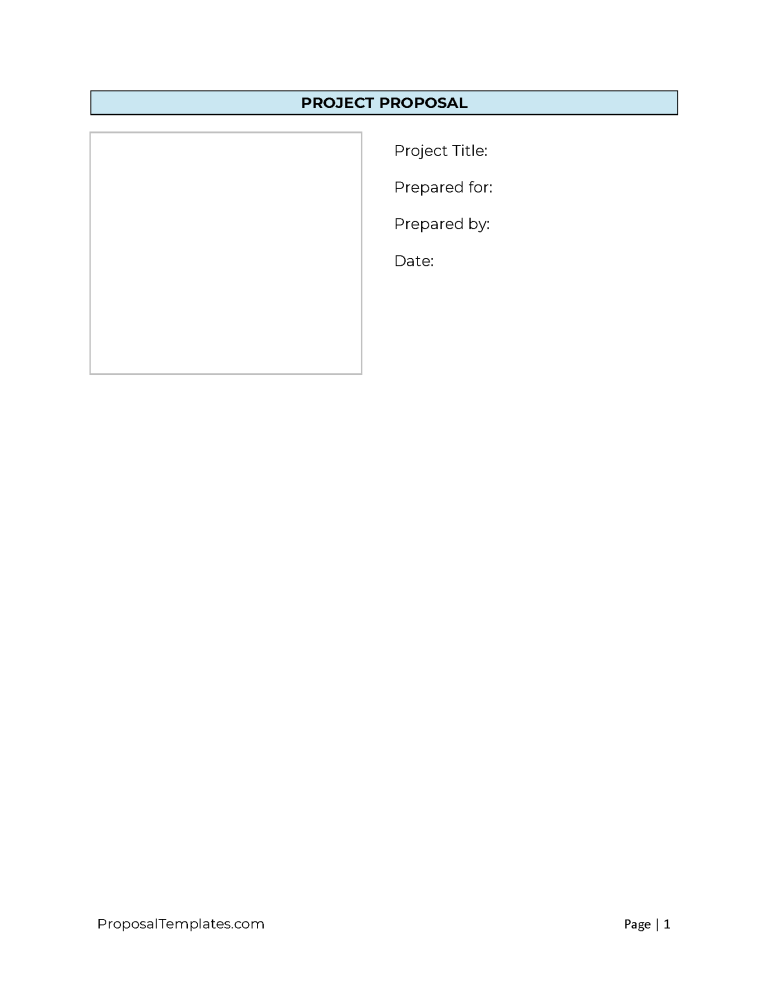Project proposals can be submitted in response to RFPs (requests for proposal) as well as for initial client contact. This document aims to significantly impress a client enough to award a project to a company or vendor.
By Type (10)
1. Project Proposal’s Title Page
Gather the elements needed to attract attention to the title page that also delivers basic information at a glance. For example, use a provocative font for the title and present the company logo.
Title, Company Logo, Contact Information
Proposal Title, Proposal Author Name
Table Of Contents
Copyright/Confidentiality Statements
Graphic Design Elements
2. Executive Summary
Set up the proposal with a comprehensive overview of its content; however, keep this brief. Consider this an opportunity to impress the client with the proposal content significantly.
Client’s Needs/Goals, Solution Offered
Project Benefits, Value Proposition
Scope Of Work, Timeline, Evaluation
Pricing, Return On Investment, Metrics
Contact Information, Visual Aids
3. Project Needs
Intrigue the client further by displaying a particularly comprehensive understanding of their needs. Whenever possible, deliberately apply the solution provided by the proposed product or service to the client’s needs.
Objective, Client’s Needs, Solutions, Resource Requirements
Scope Of Work, Challenges, Methodology, Budget
Project Phases, Key Features, Dependencies, Assumptions
Tools, Milestones, Regulatory Compliance
Quality Assurance, Deliverables, Risks, Mitigation
4. Scope Of Project Work
Explicitly define what is being done for the client, especially if on-site work is involved (i.e., installation). For example, describe the creation process for an art proposal or every physical task required in a construction proposal.
Project Goals, Detailed Task Description, Dependencies
Deliverables, Resource Allocation, Quality Standards
Change Management, Communication, Contingencies
Risks, Legal Considerations, Mitigation, Criteria
Client Responsibilities, Regulatory Compliance
5. Project Methodology
Discuss the company’s techniques for completing the project and meeting its challenges in an appropriate context (i.e., consultation, architecture, SaaS). Also, discuss the company’s mission, the preferred project tools, and timeline
Methodology Explanation, Project Phases
Resources, Roles, Responsibilities, Timeline
Tools, Quality Assurance, Data Handling
Testing, Risk Management, Innovation
Training, Documentation, Assumptions
6. Project Timeline
Present the complete project schedule, especially whenever deliverables are involved, as this will keep the client’s expectations realistic. Document additional factors (i.e., meetings) for more involved services or products.
Project Phases, Milestones, Deliverables, Start/End Date
Activity Schedule, Dependencies, Resource Allocation
Regular Updates, Reporting, Change Management
Assumptions, Constraints, Third Party Dependencies
Contingency Plan, Client Obligations, Compliance
7. Financial Information And Budgeting
Compose a budget sheet for the client so every expense and cost (i.e., labor, materials) is visible. Also, remember to report third-party costs and, of course, the estimated total estimate of the project, product, or service.
Cost Categories, Estimates, Total
Labor, Subcontractors, Materials, Equipment Supplies
Travel, Contingencies, Miscellaneous Costs, Fees, Taxes
Discounts, Incentives, Notes, Terms, Conditions
Budget Considerations, Legal Considerations
8. Resource Requirements
Most projects require at least some resources to engage and complete; henceforth, devote a section to list them. For example, identify the equipment, tools, technology, and human resources necessary to meet the client’s needs.
Staffing Plan, Team Member Profiles
Project Management, Training Requirements
Equipment, Technology, Materials, Supplies
Physical Space, Vendor, Subcontractor Engagement
Resource Availability, Resource Allocation Timeline
9. Risk Assessment And Mitigation
Produce a risk analysis of the client’s goals and needs in addition to the contingencies in place to handle them. This also applies to manufactured goods since their hazards must be listed with instructions on accident treatment (i.e., rust removers).
Risk Identification, Risk Assessment
Risk Ownership, Mitigation Strategies
Monitoring, Reporting, Resource Allocation
Risk Prioritization, Interactions, Dependencies
Constraints, Client Involvement, Lessons Learned
10. Performance Metrics
Explain how success shall be measured, especially if this is an intangible project without physical products (i.e., a marketing project). For example, any marketing sales proposal should present project metrics or KPIs (key performance indicators).
Performance Monitoring, Reporting Frequency
Key Performance Indicators (KPI), Quantifiable Metrics
Target Objectives, Testing, Continuous Improvement
Risk Managment, Mitigation, Contingencies
Client Involvement, Baseline Data, Feedback, Approval
11. Stakeholder Engagement
Identify and assess stakeholders that are significantly involved with the project, the client, and the provider. It is equally important to address the exact interests held by the stakeholders.
Roles, Responsibilities, Communication Plan
Stakeholder Involvement, Client Engagement
Vendor/Subcontractor Interactions, Conflict Resolution
Assumptions, Constraints, Training, Awareness
Reporting, Feedback, Documentation
12. Sustainability And Project Impact
If applicable, specifically lay the company’s environmentally conscious approach to the client’s project. Additionally, discuss the social or economic impact the completed objective will have, if any.
Environmental Impact Assessment, Social Impact
Economic Impact Assessment, Resource Efficiency
Sustainability, Goals, Metrics, Measurements
Social Responsibilities, Environmental Responsibilities
Community Engagement, Supporting Documentation
13. Appendices
A well-developed proposal will be easy to read; however, some attachments may hinder the overall feel. Thus, use this area to present every oversized document, chart, or visual considered part of the proposal.
References, Citations, Client Testimonials, Case Studies
Team Resumes, Bios, Certificates, Qualifications
Technical Specifications, Visual Aids, Samples, Contracts
Legal Documents, Financial Statements, Project Plans
Appendix Table Of Contents, Additional Research Data
14. Contact Information
List the company’s project contacts while inviting the client to follow up on this proposal with inquiries or a commitment. Additionally, inform the client of the best time to initiate contact.
Proposing Company/Organization Information
Project Client Information, Legal Notices, Confidentiality
Emergency Contact, Project-Specific Contacts
Preferred Contact Methods, Response Time Expectations
Alternate Contacts, Language Considerations
15. Approval And Signatures
Close the proposal with some particularly encouraging language and a summary of the terms of the sale. Also, supply a signature area for every client, stakeholder, and company representative.
Agreement/Proposal Title, Signature Lines
Proposing Company/Organization’s Signature
Witness Signatures, Notary Public Area
Confidentiality And Non-Disclosure Clauses
Proposal Summary, Instructions For Return

